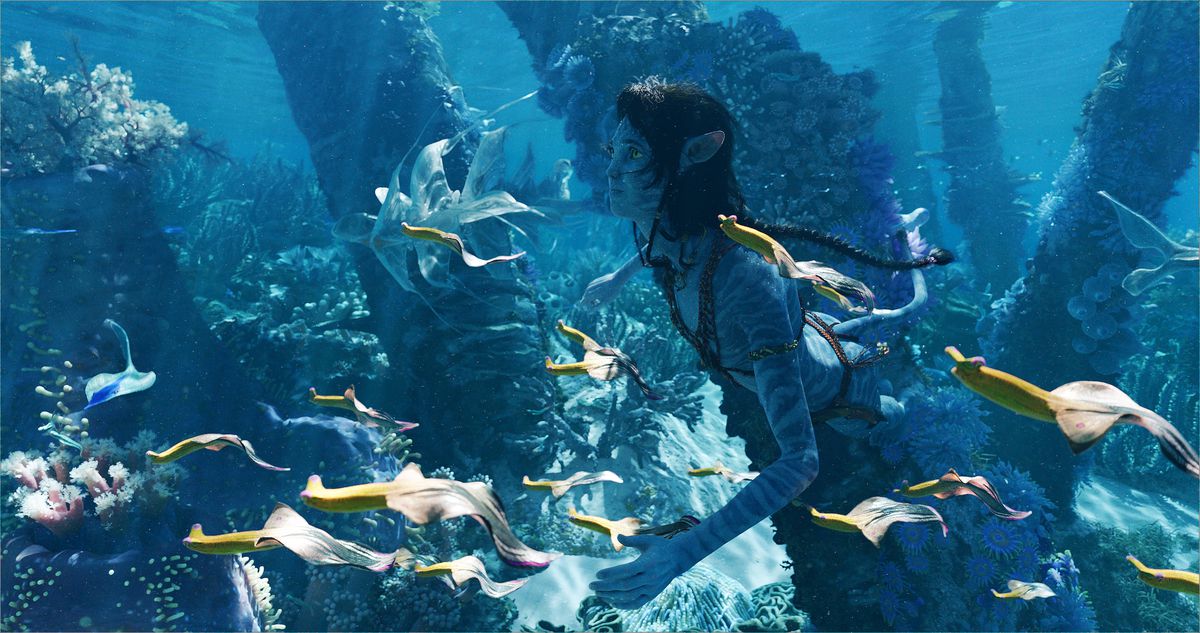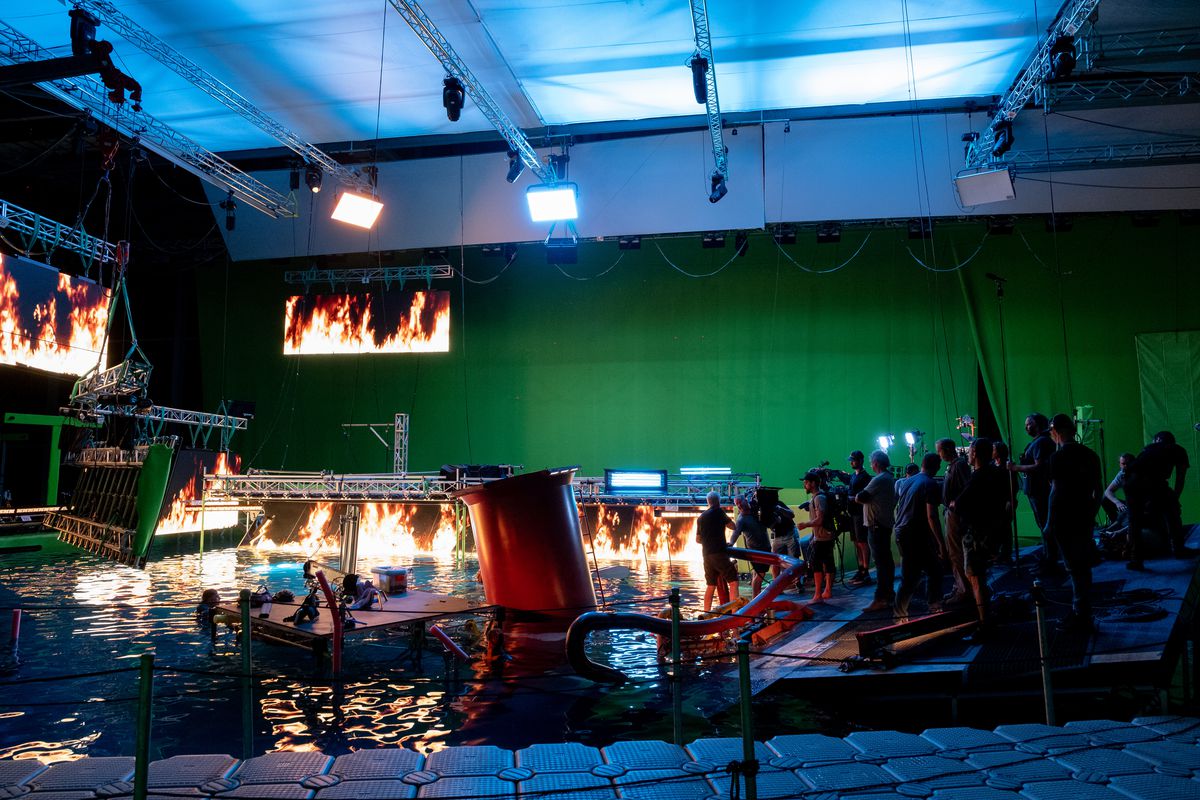There was no way James Cameron was going to make Avatar 2 like anyone else on the planet would have made Avatar 2. The pitch of “Avatar, but more water” already sounded extreme, but the obvious route of “dry-for-wet” photography — a method films like Aquaman and Black Panther: Wakanda Forever used, filming actors on floating rigs against green screen to simulate underwater motion — wasn’t enough. Cameron insisted on shooting “wet-for-wet,” which required him to reinvent the performance-capture technology used on the first film, construct an enormous “stage” tank capable of simulating every oceanic location in the film, and train his actors to free dive in order to act as the swimming Na’vi. Which is how Kate Winslet wound up with a breath-holding free-dive time of seven minutes and 14 seconds.
“You really can’t in any way call it an animated film, because everything is just based on something real,” Avatar: The Way of Water director of photography Russell Carpenter tells Polygon. “The huge tank that Jim designed could do all kinds of things — it could represent a beach, it could represent being deep underwater — and months and months of motion capture was done with that.”
For years leading up to the release of Avatar: The Way of Water, Disney and 20th Century Studios touted the Navy SEAL-level demands that Cameron’s shoot put on his actors. Before we even knew what the movie was about, or even titled, Avatar diehards were treated to photos of Winslet, Zoe Saldaña, Sam Worthington, and Cliff Curtis floating in a pool of ping-pong balls. There were glimpses of actors on pool noodles taking direction from the visionary director. One particularly shocking photo saw Winslet swooping a white cape around as she plodded across the bottom of the “ocean” floor, nose clip and goggles in place. The process looked like pure torture. But watching the completed film, in which most of the human cast has been painted over with digital Na’vi makeup, navigating CG oceanscapes tinkered with by a team of animators, I can only think… The hell was totally worth it.
Photo: Mark Fellman/20th Century Studios
Like everything Cameron does, the choice to do wet-for-wet “photography” was not just a creative gamble. In the end, the R&D budget for The Way of Water and its unknown number of sequels paid for a tank that went 32 feet deep, held 90,000 gallons of water, and could simulate appropriate waves and currents depending on whether the Na’vi were swimming in deep ocean or shifting tide pools. The New York Times recently asked Richie Baneham, a visual effects supervisor with Cameron’s company Lightstorm Entertainment, why the water effects were worth every penny.
“It’s about the credibility of the actor’s performance,” Baneham said. “If an actor is genuinely in water, there’s a viscous resistance. It informs the actor’s choices. That’s what we’re chasing. That’s what makes it feel real.”
He’s right! There’s a tangible difference between Avatar: The Way of Water and the dry-for-wet cinema of recent years. I would die for Topo the Drum-Playing Octopus in Aquaman, but Jason Momoa’s Arthur Curry often looks like he’s floating in a vat of hair gel. When Namor leads Shuri below the surface to the aquatic city of Talokan in Black Panther: Wakanda Forever, director Ryan Coogler finds majesty in the blue-hued landscapes, but keeps submerged travel to a minimum. A quick shot of the Talokanil playing a water-based version of the Mesoamerican ballgame looks more like zero-gravity space photography than anything resembling the viscosity of true water.
The dry-for-wet method doesn’t really dent the dramatic quality of either movie. Any time the characters in Aquaman or Wakanda Forever dive under for a water-based set piece, the script quickly veers back toward land to avoid the uncanny… submarine canyon? But Cameron’s all-in approach pays off, allowing him to luxuriate in the calm waters, then let it rip when the waves kick up.

Image: 20th Century Studios
There’s a physical sensation to the water work in Way of Water, likely amplified by 3D and high-frame-rate photography. When Jake Sully and his tsurak fly out of the ocean, then dive back in, there’s real weight to the action, as if actual liquid mass has been displaced. There’s a delicacy to how Kiri wipes her hand through a pod of banana-peel fish things, and a resistance to the hand motion, all thanks to Sigourney Weaver actually shooting underwater.
And while no one in their right mind would want to spend eight hours a day in a pool with their clothes on, the ask to the cast, according to costume designer Deborah Lynn Scott, was imperative to rendering realistic motion. Scott and the Way of Water costume team didn’t just create clothing for all the performance-capture work in the movie, Scott tells Polygon — many of the costumes were remade in white for underwater use. If Na’vi chieftess Ronal wears a cape into battle, Winslet wore one in the tank.
“Each piece took around 200 hours to make — it’s a very labor-intensive process,” Scott says. “So you don’t want to ruin it. But we did a tremendous amount of shooting underwater with actors swimming around in clothes and a wig. We needed to know: If Lo’ak has braids in front of his eyes and swims forward, where did those braids go? And then if [his hair] settles down and gets in his way, what’s his movement with it? The interaction between performance and costume can’t be done without having the real costume.”
The tactile philosophy was even applied to the Na’vi’s tulkun pals. According to Carpenter, it took a squad of divers wearing performance-capture suits to jump in the pool and fill in when a Pandoran whale was called for, so actors like Britain Dalton, who plays Lo’ak, could float alongside the creature, or be hurled off it with a significant splash.


Photos: Mark Fellman/20th Century Studios
The ultimate test of Cameron’s wet-for-wet vision comes when the Na’vi battle the humans in the final act, and a tulkun flips over the whale-hunting ship The Sea Dragon. Recalling Cameron’s work on Titanic, the confrontation finds human and Na’vi characters alike sloshing about in flooded rooms and zipping across the seabed. Quaritch’s teen son Spider, played by Jack Champion, swims alongside his found Na’vi family in the sinking ship. That moment could have easily broken the illusion if it were an entirely CG construct. But all of the actors were weaving in and out of some kind of metal obstacle course, whether built in part for performance capture or constructed as a live-action element. Carpenter says most of his on-set work as the director of photography involved the Spider sequences. He calls the difficulty of lighting for Spider’s reflective breathing apparatus and matching the physics of the performance capture “a major pain in the butt.” (He also says, amazingly, the already complete Avatar 3 involved more underwater photography across live-action and performance-capture than The Way of Water.)
Eyes vary, so reactions to the underwater footage do, too. But after years of watching the cast of Avatar: The Way of Water smile through the grind of making the damn thing, I was blown away by the results. The payoff is one of a kind: palpable yet alien, and in service to selling Jake and Neytiri’s Na’vi family as a real set of beings surviving an unfathomable war. That’s Cameron’s real trick: Yes, the imagery looks cool, but the realer it feels when Kiri floats inches above the sand, being one with nature, the more these digital creations have a soul.
In 2009, Cameron and his VFX team at Weta hoped to unlock true humanity in a CG character by focusing on the eyes of the Na’vi. But 13 years later, thanks to the magic of sense memory, they’ve come closer than ever. All it took was a little bit of water.
